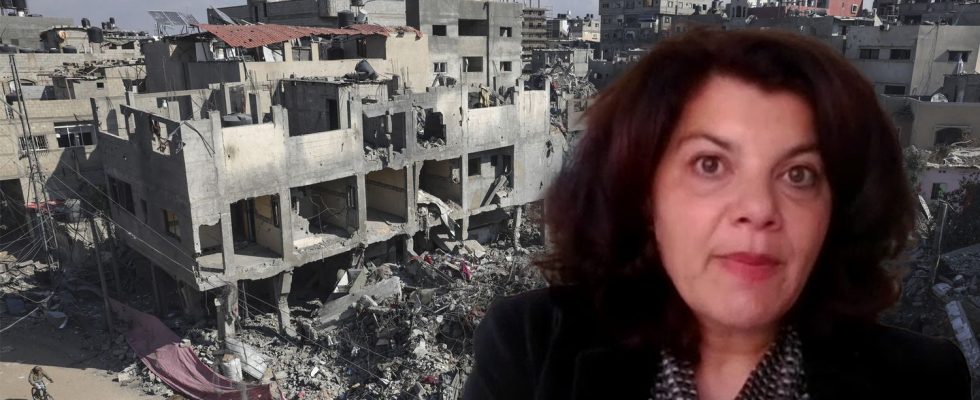In Gaza, the delivery of drinking water by truck, but also the operation of bakeries and even generators managed by the UN could cease from November 15.
The United Nations soon to be powerless in Gaza? UNRWA, the UN agency for Palestinian refugees, warned on Monday November 13 that “Humanitarian operations will cease within 48 hours, no fuel allowed” to be delivered to Gaza. Without trucks, the delivery of drinking water could, for example, come to an abrupt end for more than 200,000 people, according to the UN agency.
>> Find the latest information on the conflict between Israel and Hamas in our live stream
Less than 24 hours before this crucial aid is stopped, while fighting continues between Hamas and the Israeli army around and within the enclave, franceinfo spoke with Tamara Alrifai, spokesperson for the ‘UNRWA, to better understand the urgency of the situation.
franceinfo: Do you have precise information on the displaced in Gaza? Where are they settled and in what conditions do they live?
Tamara Alrifai: Today, we are talking about 1.6 million displaced people out of a total population in Gaza of 2.2 million. In mathematical terms, this represents between 70 and 80% of the population of Gaza, most of whom are displaced from the northern zone to the southern zone. Nearly 800,000 people are now in schools and UNRWA shelters (the United Nations agency for Palestine refugees).
They are in truly deplorable humanitarian conditions, even in United Nations shelters.
Tamara Alrifai, UNRWA spokespersonat franceinfo
It must be said that there is a lot of space in these shelters. Nearly 800,000 people are housed in 154 schools, most of them buildings that were not ready to receive refugees. There are not enough places, not enough toilets or showers. There is also not enough food or clean water to distribute. The daily conditions are really very trying.
franceinfo: Do you have any news from the civilians who remained in northern Gaza?
Many have stayed at home and many families find themselves in around fifty UNRWA schools. We have not had access to these people since we moved from the North to the South. Many did not want to leave Gaza because they did not want to be displaced. These Palestinians often tell us that they are “the descendants of the refugees of 1948, we know that they never came back and therefore we do not want to go now to the south or elsewhere and never come back”.
There are also people who physically cannot make this trip. These are either people with disabilities, pregnant women or even elderly people who cannot travel several kilometers on foot. We saw these images of mothers with three or four children in their arms, a plastic bag with food, a container with water. These are very difficult journeys.

Israeli authorities accuse Hamas of using UN sites, schools and hospitals as military bases or weapons caches. What do you say to that?
We are responsible for our facilities and schools above ground. We carry out inspections inside our schools on a very routine basis, once a term, to ensure that they are neutral and comply with United Nations standards. [En revanche]we are not able to know what is happening below our schools […] We go even further, since we inspect and ensure the profile of all our employees.
We share the GPS coordinates of all our installations with the Israeli authorities and with Hamas […]to make sure everyone knows where these UN buildings are.
Tamara Alrifai, UNRWA spokespersonat franceinfo
We also have direct contacts with the Israeli authorities. If they miss the blue flag, they know with the GPS coordinates that the schools, facilities, warehouses are there. We are in continuous communication with the Israeli authorities on everyday operations: the movement of our trucks, our reading of the humanitarian situation.
How does the siege of Gaza affect the aid you provide?
We are one day away from suspending all our activities, because we no longer have fuel to run our trucks, our water desalination plants, our generators for electricity, the bakeries we support. From tomorrow, we will no longer be able to operate, and that is something that we also share with the Israeli authorities.
Do you have any information regarding the situation at al-Chifa hospital?
We know what the World Health Organization said: for three days, this hospital has not been functioning. We were in contact with this hospital before it stopped operating because, like other UN agencies and the JRC, we consider al-Chifa Hospital to be a pillar of public health in Gaza.
It is an iconic hospital. It is probably the oldest hospital in the Gaza Strip and one that has survived many wars. It is also the one which receives the greatest number of war wounded during all conflicts. The fact that this hospital is ceasing to function is, for us, a very, very serious deterioration in the state of health in its broad sense in Gaza.

What do you expect from the international community?
There needs to be an immediate ceasefire. We have heard a lot about “break” or “humanitarian truce”, but it is really insufficient. This is also a theme that the French president used, and we are really very indebted to him. From this humanitarian ceasefire, the flow of humanitarian aid entering Gaza must be sufficient. Today, we have at best around fifty trucks passing through Egypt from the Rafah crossing, which is very restricted.
Logistically, it is a limited passage which was never designed to pass more than fifty trucks per day. However, before this war and despite the blockade, between 500 and 600 trucks of commercial goods arrived every day in Gaza to supply grocery stores, businesses… […] Using this passage exclusively is therefore not logical. What we are asking for is to be able to consider other crossings, including the crossing inside Israel, Kerem Shalom, which allows the passage of several hundred trucks.
